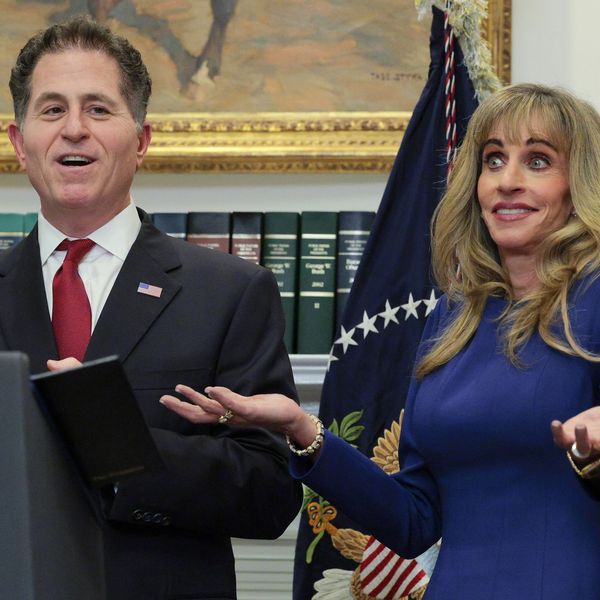
Do the math. The pay gap is not just infuriating. It's obscene. (Image: Shutterstock)
The Arithmetic of the CEO-Worker Pay Divide
Sometimes percentages alone don't do justice to the injustice of corporate compensation
The Economic Policy Institute reported earlier this month that the average CEO of the 350 largest firms in the U.S. pocketed $18.9 million in 2017, a 17.6 percent pay increase over 2016.
At the same time, typical worker compensation remained flat, rising merely 0.3 percent.
If you do some quick math, dividing 17.6 percent by 0.3 percent, you might conclude that CEO pay in 2017 increased about 60 times faster than worker pay.
But if you take a moment and do some more careful calculations, that CEO-worker pay gap will soar incredibly higher -- to a CEO pay boost over 15,000 times the pay hike for workers.
Let's go through the arithmetic. In 2016, before the latest whopping CEO pay hikes, America's top executives were already making 270 times worker pay. So for each dollar of worker pay that increased by 0.3 percent between 2016 and 2017, $270 of CEO pay increased by 17.6 percent.
To visualize this a bit more simply, let's compare a CEO paid $9,000,000 in 2016 with a worker at the same corporation paid 1/270th as much as that CEO, or $33,333.
A 17.6 percent increase for the CEO would translate to a tidy $1,584,000 pay raise. Not bad work if you can get it, huh? On an hourly basis, our lucky CEO saw his pay increase by $792, from $4,500 per hour to $5,292 per hour.
And the worker? A 0.3 percent increase over a $33,333 salary would translate to a whopping $100 raise. That's right, a little under $2 per week.
The bottom line: Our CEO saw a pay increase 15,840 times the pay boost our worker received. In other words, for every additional dollar our average worker earned in 2017 compared to 2016, our average CEO took home an additional $15,840.
Another perspective on our numbers: After one hour of labor in 2017, our CEO grabbed a pay increase over the previous year nearly eight times as much as the increase our worker received for the entire year.
An Urgent Message From Our Co-Founder
Dear Common Dreams reader, The U.S. is on a fast track to authoritarianism like nothing I've ever seen. Meanwhile, corporate news outlets are utterly capitulating to Trump, twisting their coverage to avoid drawing his ire while lining up to stuff cash in his pockets. That's why I believe that Common Dreams is doing the best and most consequential reporting that we've ever done. Our small but mighty team is a progressive reporting powerhouse, covering the news every day that the corporate media never will. Our mission has always been simple: To inform. To inspire. And to ignite change for the common good. Now here's the key piece that I want all our readers to understand: None of this would be possible without your financial support. That's not just some fundraising cliche. It's the absolute and literal truth. We don't accept corporate advertising and never will. We don't have a paywall because we don't think people should be blocked from critical news based on their ability to pay. Everything we do is funded by the donations of readers like you. Will you donate now to help power the nonprofit, independent reporting of Common Dreams? Thank you for being a vital member of our community. Together, we can keep independent journalism alive when it’s needed most. - Craig Brown, Co-founder |
The Economic Policy Institute reported earlier this month that the average CEO of the 350 largest firms in the U.S. pocketed $18.9 million in 2017, a 17.6 percent pay increase over 2016.
At the same time, typical worker compensation remained flat, rising merely 0.3 percent.
If you do some quick math, dividing 17.6 percent by 0.3 percent, you might conclude that CEO pay in 2017 increased about 60 times faster than worker pay.
But if you take a moment and do some more careful calculations, that CEO-worker pay gap will soar incredibly higher -- to a CEO pay boost over 15,000 times the pay hike for workers.
Let's go through the arithmetic. In 2016, before the latest whopping CEO pay hikes, America's top executives were already making 270 times worker pay. So for each dollar of worker pay that increased by 0.3 percent between 2016 and 2017, $270 of CEO pay increased by 17.6 percent.
To visualize this a bit more simply, let's compare a CEO paid $9,000,000 in 2016 with a worker at the same corporation paid 1/270th as much as that CEO, or $33,333.
A 17.6 percent increase for the CEO would translate to a tidy $1,584,000 pay raise. Not bad work if you can get it, huh? On an hourly basis, our lucky CEO saw his pay increase by $792, from $4,500 per hour to $5,292 per hour.
And the worker? A 0.3 percent increase over a $33,333 salary would translate to a whopping $100 raise. That's right, a little under $2 per week.
The bottom line: Our CEO saw a pay increase 15,840 times the pay boost our worker received. In other words, for every additional dollar our average worker earned in 2017 compared to 2016, our average CEO took home an additional $15,840.
Another perspective on our numbers: After one hour of labor in 2017, our CEO grabbed a pay increase over the previous year nearly eight times as much as the increase our worker received for the entire year.
The Economic Policy Institute reported earlier this month that the average CEO of the 350 largest firms in the U.S. pocketed $18.9 million in 2017, a 17.6 percent pay increase over 2016.
At the same time, typical worker compensation remained flat, rising merely 0.3 percent.
If you do some quick math, dividing 17.6 percent by 0.3 percent, you might conclude that CEO pay in 2017 increased about 60 times faster than worker pay.
But if you take a moment and do some more careful calculations, that CEO-worker pay gap will soar incredibly higher -- to a CEO pay boost over 15,000 times the pay hike for workers.
Let's go through the arithmetic. In 2016, before the latest whopping CEO pay hikes, America's top executives were already making 270 times worker pay. So for each dollar of worker pay that increased by 0.3 percent between 2016 and 2017, $270 of CEO pay increased by 17.6 percent.
To visualize this a bit more simply, let's compare a CEO paid $9,000,000 in 2016 with a worker at the same corporation paid 1/270th as much as that CEO, or $33,333.
A 17.6 percent increase for the CEO would translate to a tidy $1,584,000 pay raise. Not bad work if you can get it, huh? On an hourly basis, our lucky CEO saw his pay increase by $792, from $4,500 per hour to $5,292 per hour.
And the worker? A 0.3 percent increase over a $33,333 salary would translate to a whopping $100 raise. That's right, a little under $2 per week.
The bottom line: Our CEO saw a pay increase 15,840 times the pay boost our worker received. In other words, for every additional dollar our average worker earned in 2017 compared to 2016, our average CEO took home an additional $15,840.
Another perspective on our numbers: After one hour of labor in 2017, our CEO grabbed a pay increase over the previous year nearly eight times as much as the increase our worker received for the entire year.

